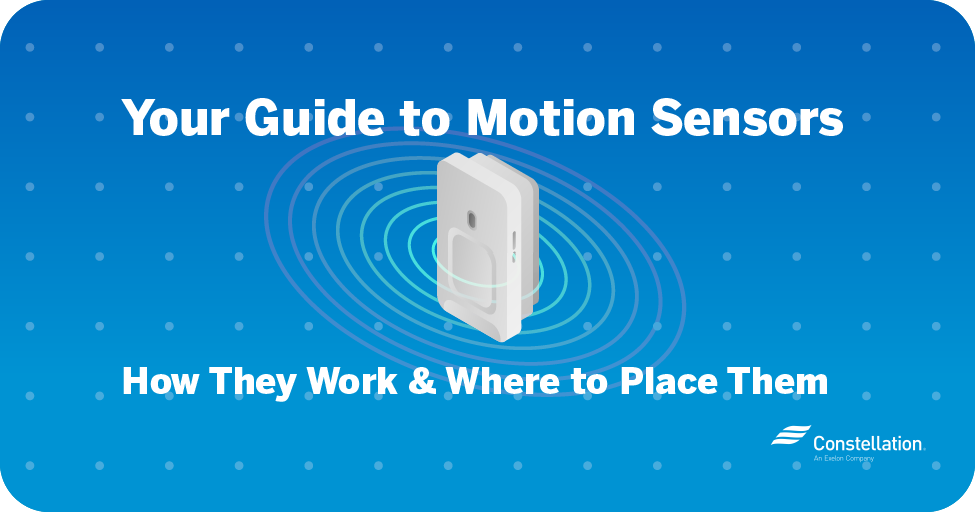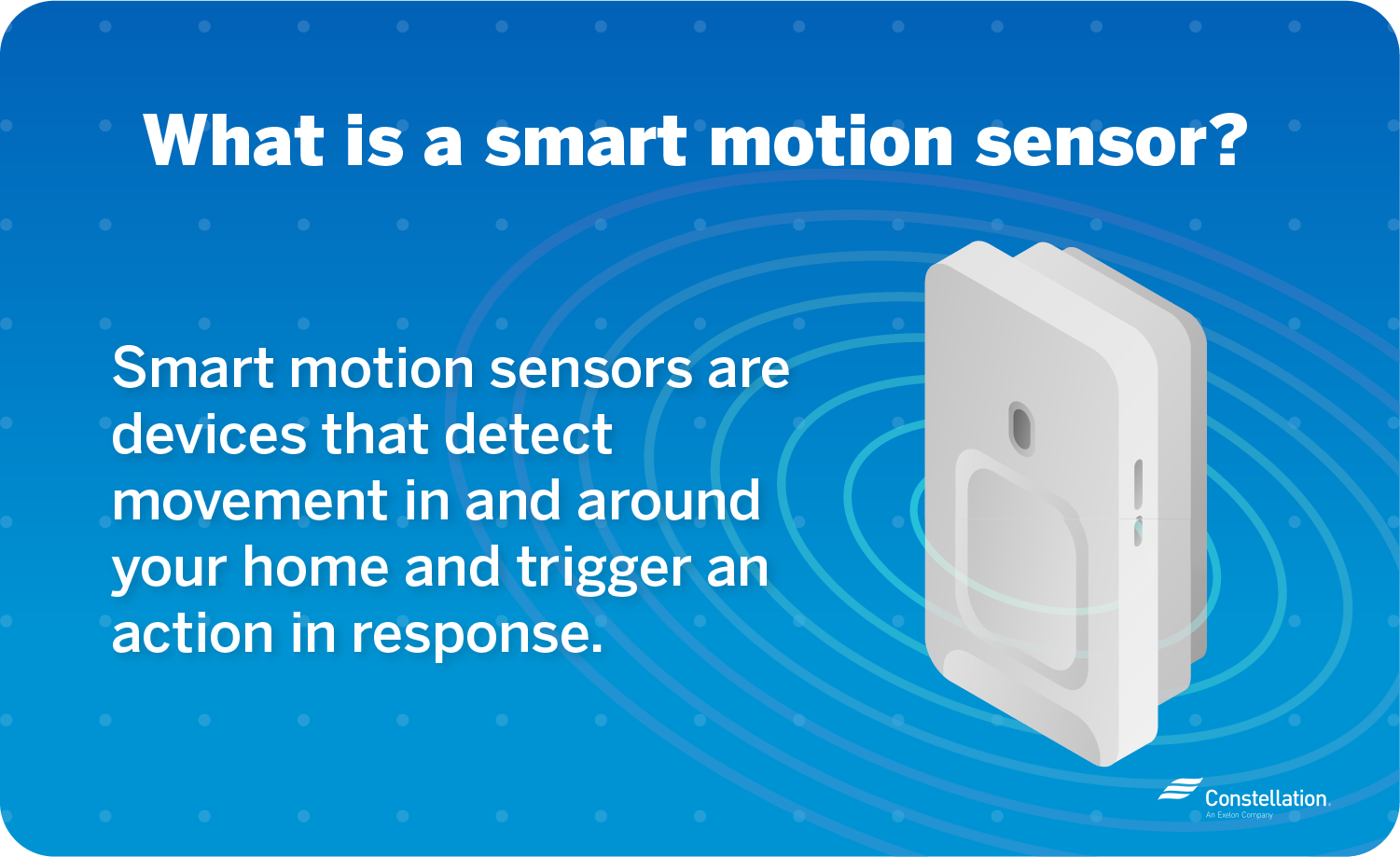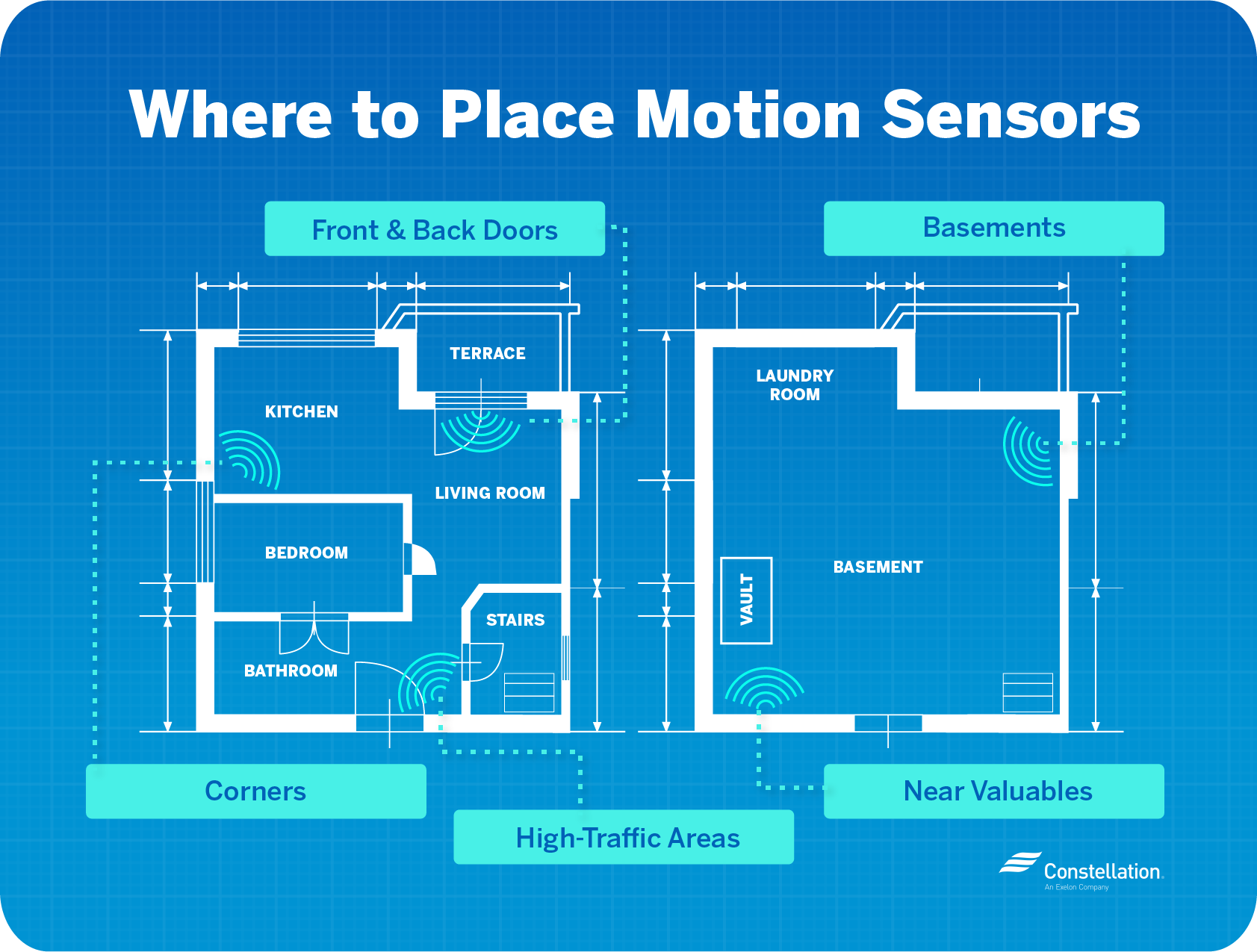
- Category:
Home Energy Savings -
Last updated:
May 14, 2021
Your Guide to Motion Sensors: How They Work & Where to Place Them
When it comes to home technology, smart motion sensors are some of the more efficient and versatile devices you can buy. But in order to get the full security and convenience that motion sensors offer, there’s a few best practices you’ll want to follow. That’s why we’ve put together a guide explaining everything from the best motion sensor uses and locations to tips for installation.
What is a smart motion sensor?
Smart motion sensors are devices that detect movement in and around your home and trigger an action in response. For example, a smart motion sensor can automatically turn the lights on when it senses you enter a room. Or they can send you an alert if an intruder is attempting to enter your home. Ultimately, the purpose of motion sensors is to provide peace of mind and help your home operate more smoothly and efficiently.

How do smart motion sensors work?
Most smart motion sensors work by using passive infrared (PIR) technology. PIR sensors detect infrared energy, which humans and other animals give off as body heat. So, when a sudden increase in temperature occurs, your device will notice the change and proceed to alert your system’s control panel. It’s worth noting that PIR sensors can be programmed to ignore minor changes in temperature, which means you don’t have to worry about your pets accidentally setting off alarms.
Other types of smart sensors for your home
Motion sensors aren’t the only types of smart sensors worth investing in. For example, there are some other smart sensors that can make your house a more secure and efficient place:
- Temperature sensors. Temperature sensors, such as those found within smart thermostats, monitor temperature in your home and allow you to better control it, saving you energy in the process.
- Light sensors. Light sensors read the amount of sunlight your home receives and are often used to automate the lighting features on smart security systems.
- Smoke detectors. Smart smoke detectors can not only detect fires within your house but also be programmed to send fire alerts to your smartphone or other connected device.
- Water leak sensors. Water leak sensors help to prevent water damage in your home by sending alerts to your smartphone as soon as a leak is detected.
- Air quality sensors. Air quality sensors detect carbon monoxide and other contaminants in your home’s air and can alert you if levels get too high.
Ways to use motion sensors in your home
You know what motion sensors are and how they work, so the next step is to figure out how to use motion sensors in your home. These devices can be utilized in a variety of different ways, all of which can help keep your home as protected and energy-efficient as possible.
1. Protect doors, windows and entryways.
One common use for motion sensors is to protect your doors, windows and other entryways from potential break-ins. Simply mount your security sensors near these points of entry and connect the devices to your smartphone or tablet. If an intruder attempts to enter your house, you’ll automatically be notified. And if your security system has a camera, you may be able to program it to record any activity it detects.
Beyond the increased protection, there are some other benefits to automating your home security system. For example, most automated security systems can be controlled or adjusted remotely. And they may even be able to earn you smart home insurance discounts.
2. Detect leaks and changes in water temperature.
Motion sensors can also be used to detect water leaks as well as sudden changes in water temperature. This helps to prevent flooding and other types of water damage in your home. To get the most out of your sensors, place them underneath dishwashers, sinks and other appliances that are liable to leak. Then, pair your smart device to the sensors in order to receive alerts about leaks or other water issues as soon as they’re detected.
3. Monitor your home for broken glass.
Another way that motion sensors help to secure and protect your home is by monitoring the premises for glass breaking. When glass break detectors pick up on the sound of breaking glass, you can set the device to trigger an alarm as well as send notifications to your smartphone or other connected device. This effectively deters break-ins and offers increased peace of mind when you’re away from home for long periods.
4. Turn lights on or off automatically.
Installing motion sensor lights can help improve security and promote energy savings in the home. Once set up, these devices automatically turn on or off when someone enters or leaves a room, meaning you don’t have to worry about forgetting to adjust your light switches. Additionally, these lights can be added to your home security system and programmed to turn on when suspicious activity is detected.
5. Limit access to certain parts of your home.
Motion sensors are great for keeping certain areas of your house restricted, as they can detect motion in designated spaces and send alerts notifying you of the unwanted activity. It’s as easy as placing your sensor in the desired location and then pairing it to an internet-connected device, such as a smartphone. This feature can be especially useful if you live in a household with young children or pets.
Where to place motion sensors
In order for your motion sensors to work up to their full potential, you’ll want to make sure they’re located in the right areas of your home. Here are some of the most effective spots to place motion sensors:

- Corners. Installing a motion sensor in the corner of your room will give your sensor the widest possible view of the space below. Just be sure that the sensor is pointed at the doorway, with no obstructions in the way.
- Front and back doors. Placing motion sensors above doorways keeps them out of sight and makes it nearly impossible for intruders to enter without setting off the alarm.
- High-traffic areas. Equipping stairways, main hallways and other high-traffic areas with motion sensors ensures that intruders trigger the alarm regardless of where they’re trying to get to.
- Near valuables. Putting a motion detector near or behind valuable items will make it so that the alarm is sounded if an intruder attempts to move or steal them.
- Basements. Intruders may attempt to make a low-profile entry through your basement, so it’s wise to have the space equipped with motion sensors. For the best results, the sensors should be directed at doors and windows, with no clutter in the way.
More best practices for motion sensor placement
The location of your motion sensors can have a substantial impact on how well the devices perform. Here are a few best practices to follow when determining ideal motion sensor placement:
- Install motion sensors in areas where an intruder would be most likely to enter.
- Place motion sensors at least 6–8 feet off the ground.
- Ensure that there are no obstructions blocking your motion sensor’s line of sight.
- Keep motion sensors away from air vents, radiators and other sources of heat.
- Use motion sensors in climate-controlled rooms.
- Align motion sensors in a way that will force intruders to walk across the sensor’s range rather than toward it.
Installing motion sensors in your house
Although the process may differ based on the type of motion sensor you have and your particular home’s layout, there are some general steps to follow when installing motion sensors in your home:
-
- Open your motion sensor and ensure you have everything you need, including batteries.
- Choose a location for your motion sensor, either indoor or outdoor.
- Attach the mounting bracket to the desired wall or surface.
- Place the motion sensor in the mounting bracket, checking to make sure it’s steady and stable.
- Sync your motion sensor to your smartphone, smart home hub or other connected device.
- Adjust your motion sensor’s settings and develop automation schedules.
- Clean your motion sensor every few months for it to keep working efficiently.
Making the most of your home motion sensors
If you’re looking to set up a smart home, motion sensors are a simple and cost-effective place to start. These versatile devices can help with everything from improving your home’s security to reducing the amount of energy you consume on a daily basis. And that’s not to mention the additional efficiency and convenience that motion sensors offer. Following the tips and instructions we’ve laid out is the best way to ensure that your motion sensors are worth the investment.




